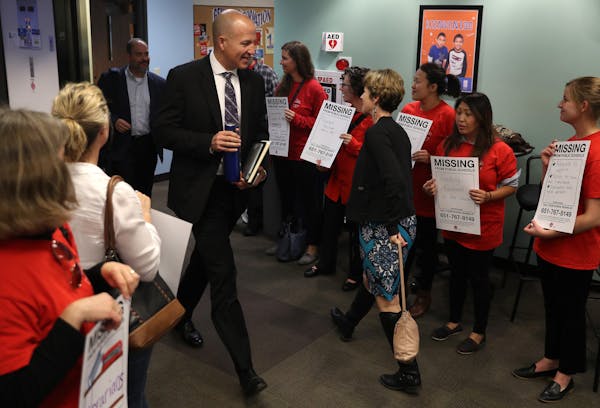Election Day approaches with a long list of school building projects being pitched to metro area voters, some in surprising places.
New elementary schools are envisioned in the Anoka-Hennepin, Wayzata and Prior Lake-Savage districts — moves one could expect of big or growing school systems in a typical election year.
But this season marks the comeback, too, of the inner-ring suburban district, most notably Roseville and Mounds View. Each is eyeing projects totaling more than $100 million. After decades of shrinkage and school closures, inner-ring districts today account for nine of the 20 fastest-growing in the Twin Cities area. Some are turning away nonresidents once needed to fill classrooms and balance budgets.
Open enrollment, which allows students who live elsewhere to cross district lines, also has been part of the election conversation. In the Roseville and Prior Lake-Savage districts, some people wonder whether their proposed new spaces are aimed at kids not living in the district.
Roseville, Prior Lake-Savage and Mounds View fall in the class of "winners" when it comes to kids they gain versus those they lose through open enrollment. A recent Star Tribune analysis of state enrollment data showed that open enrollment and charter schools are increasingly popular with suburban families, with more than 48,000 suburban students taking advantage of school choice options in 2016-17.
In Roseville, officials say their building plans are for Roseville students, and they believe they've satisfied concerns. In Prior Lake-Savage, questions linger over how the district handles open enrollment. There, the district is proposing $109 million worth of projects — a year and a half after voters rejected a similar package priced at $150 million.
'Not a great year'
In St. Anthony-New Brighton, another district that gains more open enrollment students than it loses, voters approved a $14 million bond for elementary school improvements in September after the district emphasized that its need for new space was dictated not by nonresident students, but by the projected growth of students who live within its boundaries.
The proposed metrowide building spree is the marquee feature in an otherwise ordinary slate of district ballot proposals. Sixteen districts within the Association of Metropolitan School Districts also are asking voters for operating funds, but many of the requests are renewals of existing voter-approved levies.
Not that districts are particularly pleased with the state of preschool-to-grade-12 finances.
"It was a decent funding year, but not a great year" at the State Capitol, said Scott Croonquist, executive director of the metro schools group. Districts will see 2 percent increases this year and next in the bedrock per-pupil funding formula. That does not cover what districts say is the perpetual underfunding of special education and English language learner services, among other programs.
The 11 bond proposals, which involve capital spending, are probably more than in recent years, Croonquist said.
The development is not surprising, however, he said, given the state's expanded preschool options, enrollment growth in some of his member districts and the need for districts like Roseville and Mounds View to tend to aging facilities.
The state's largest school district, Anoka-Hennepin, is proposing two new elementary buildings in its $249 million bond package.
For voters with young children, the idea of a new elementary school can have instant appeal. Modern, eco-friendly features. Spacious hallways and-or pullout rooms for small-group instruction. Grass fields and playground amenities. What's not to like?
Inner-ring growth
But schools in the inner ring have needs, too, with a common theme being a physical plant installed in the mid-20th century that hasn't seen a lot of updating. Security features can be lacking, too, in an age of concern about mass shootings.
"The world has moved on both outside and inside our buildings," said Steve Unowsky, superintendent of the Richfield Public Schools, which has an $86.8 million bond proposal on the ballot. "There's significant parent drop-off these days, fewer walkers and bus drivers, more multicar families, and our traffic flow wasn't set up for that. Inside, the science lab of yesterday was that large black table, where today it's a computer-simulated dissection that didn't use to be an option."
Inner-ring districts face a challenge, though: a core of older voters on fixed incomes for whom "yes" votes can mean a big tax hike. In Roseville, the proposal would add more than $400 a year for median-valued homes. In New Brighton, a City Council member held her tax form up to visiting leaders from the Mounds View district and said of the $400-plus bump she faces: "That's kind of a kick, right?"
Yet demographers point to the thousands of inner-ring residents over 75 as a sign that homes will soon be turning over to a new generation; the return of families with children will challenge already overcapacity schools.
At Irondale High in the Mounds View district, the "four corners" area becomes a traffic jam during passing times, officials say. The district's $164.8 million ask is one of the biggest in the metro area. But officials say most buildings are already beyond capacity, with another 1,600 students expected within seven years.
Mounds View draws 10 percent of its students from outside the district. But Superintendent Chris Lennox said people have told him that they are seeing houses turning over and kids coming into the district. A boom in young families, and the idea of the district educating its own, means something to them, he said.
In neighboring Roseville, 19 percent of students come from elsewhere, but Superintendent Aldo Sicoli made clear that the district's building plan is based on projected growth within.
Still, he added, "it's an honor to be a destination district" to those now living outside it.
anthony.lonetree@startribune.com • 612-673-4109
dapeterson@startribune.com • 651-925-5039
Want to celebrate 4/20? Here are 33 weed-themed events across Minnesota.

Legendary record store site in Minneapolis will soon house a new shop for musicheads

Former Gov. Jesse Ventura boasts he could beat unpopular Trump or Biden if he ran for president

